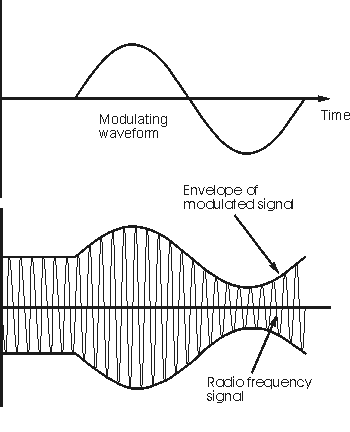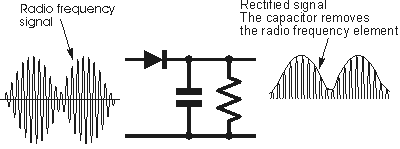Amplitude modulation (AM) is a form of modulation used for radio transmissions for broadcasting and two way radio communication applications. A modulating waveform or carrier wave has the signal to be transmitted superimposed on it.
AM is used for audio broadcasting on long, medium and short wave bands, and for two way radio communication using VHF for aircraft. The use of other methods means it use is now declining.

Amplitude Modulation, AM
When a carrier is modulated in any way, further signals are created that carry the actual modulation information. When a carrier is amplitude modulated, further signals are generated above and below the main carrier. To see how this happens, take the example of a carrier on a frequency of 1 MHz which is modulated by a steady tone of 1 kHz.
The process of modulating a carrier is exactly the same as mixing two signals together, and as a result both sum and difference frequencies are produced. Therefore when a tone of 1 kHz is mixed with a carrier of 1 MHz, a "sum" frequency is produced at 1 MHz + 1 kHz, and a difference frequency is produced at 1 MHz - 1 kHz, i.e. 1 kHz above and below the carrier. Then the top spectra will extend to 1 kHz above and below the signal. In other words the bandwidth occupied by the AM signal is twice the maximum frequency of the signal that is used to modulated the carrier, i.e. it is twice the bandwidth of the audio signal to be carried
If the steady state tones are replaced with audio like that encountered with speech of music, these comprise many different frequencies and an audio spectrum with frequencies over a band of frequencies is seen.
The process of demodulation, where the audio signal is removed from the radio carrier in the receiver is simple. The easiest method of amplitude demodulation is to use a simple diode detector. This consists of just a handful of components:- a diode, resistor and a capacitor.

AM Diode Detector <
The diode rectifies the signal, allowing only half of the alternating waveform through. The capacitor is used to store the charge and provide a smoothed output from the detector, and to remove any unwanted frequency components. The resistor is used to enable the capacitor to discharge. If it were not there and no other load was present, then the charge on the capacitor would not leak away, and the circuit would reach a peak and remain there.
There are several advantages of amplitude modulation, and some of these reasons have meant that it is still in widespread use today:
-
It is simple to implement
-
it can be demodulated using a circuit consisting of very few components
-
AM receivers are very cheap as no specialised components are needed.
Amplitude modulation is a very basic form of modulation, and although its simplicity is one of its major advantages, other more sophisticated systems provide a number of advantages. Accordingly it is worth looking at some of the disadvantages of amplitude modulation.
-
It is not efficient in terms of its power usage
-
It is not efficient in terms of its use of bandwidth, requiring a bandwidth equal to twice that of the highest audio frequency
-
It is prone to high levels of noise because most noise is amplitude based and obviously AM detectors are sensitive to it.
